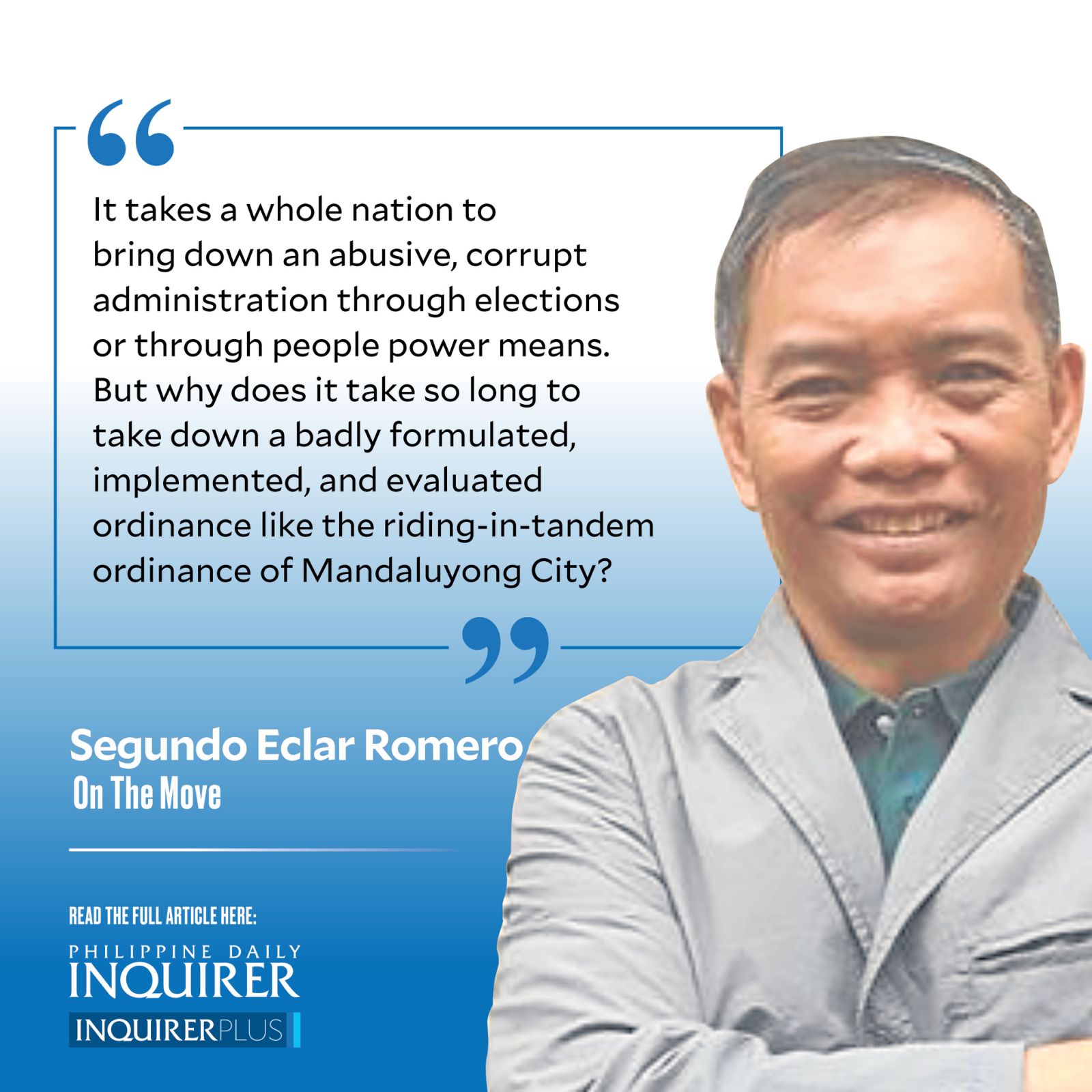Quixotic ordinance

It takes a whole nation to bring down an abusive, corrupt administration through elections or through people power means. But why does it take so long to take down a badly formulated, implemented, and evaluated ordinance like the riding-in-tandem ordinance of Mandaluyong City?
This ordinance was first enacted in 2014 for a trial period of six months. It was inspired by a visit by former mayor Benjamin Abalos Jr. to Medellin, Colombia. The trial period was judged a success by the Mandaluyong City government, so another ordinance extended its life for another three years. In 2018, the Mandaluyong Peace and Order Council attested in its January 2018 meeting that crimes committed by riding-in-tandem perpetrators continued to decrease. Meantime, the income of the city from arrested violators who chose not to contest the violation had increased.
The ordinance was finally challenged by lawyer Dino de Leon, who was apprehended in March 2019 while commuting using the commercial ride-sharing service Angkas. He paid the P2,000 fine under protest and wrote a letter contesting the apprehension. The City of Mandaluyong then had to file a criminal complaint against him. De Leon filed a petition assailing the constitutionality of the ordinance, with a prayer that a restraining order be issued against its implementation by Mandaluyong. In July 2020, the Mandaluyong Regional Trial Court dismissed his petition for lack of merit. De Leon filed for reconsideration, which was also dismissed in October. De Leon persisted, elevating the case to the Court of Appeals.
Finally, on Sept. 28 this year, the Court of Appeals prohibited the Mandaluyong City government from implementing City Ordinances No. 550 of 2014, 595 of 2015, and 694 of 2018, for being oppressive, arbitrary, discriminatory, and going “beyond what is reasonably necessary for the accomplishment of the purpose” of the ordinance.
So, it seems that Dino de Leon was the one referred to by Mayor Abalos when, in urging the Sangguniang Panlungsod to pass the initial riding-in-tandem ordinance in 2014, he reminded them that “the only thing necessary for evil to triumph is for good men to do nothing.” Did they suspect they were the evil ones and Dino de Leon the good?
The primary evil that the ordinance did was exactly what the third ordinance was crowing about—the “substantial amount of income [that] was delivered to the coffers of the City.” De Leon estimates that at P200 million collected from 100,000 violators—the result of the arrested violators being unwilling to contest the apprehension and take on City Hall. The bureaucratic hassle was not worth it, even if, for many ordinary workers depending on motorcycles for their livelihood and transportation to work, the P2,000 fine was a whole week’s wage. Mandaluyong could have used the money it collected to validate their assumptions and obtain more information about the impact of their riding-in-tandem ordinances.
So much has been written about the quixotic ordinance, which has not presented any real evidence to support the policy other than it coincided with what the Mandaluyong authorities themselves report as the reduction in crimes. Apart from the absence of causal relationships shown about the effects of gender, degree of consanguinity, and age in the propensity to engage in riding-in-tandem crimes, the language of the ordinances themselves (grammar, font, vocabulary, typographical errors) shows a poor level of care and probity in the formulation of such a critical legislation, which adversely affected the poor, vulnerable, and disadvantaged members of society.
The lesson to be learned from this is for local governments to approach their policymaking tasks with design thinking in mind. They should consult the various stakeholders and engage experts who can help them with evidence-based policy formulation, which requires a level of science, technology, and innovation adeptness not normally expected of politicians. Haven’t they heard about the National Research Council of the Philippines, or the National Academy of Science and Technology, which are government policy-advice institutions?
This being a policy design and analysis issue, the stakeholders should also have helped themselves by proposing responsive, technically feasible, and financially viable solutions to the Mandaluyong City government. They gouged themselves by leaving the policymaking entirely to the Sangguniang Panlungsod.
—————-
doyromero@gmail.com




















